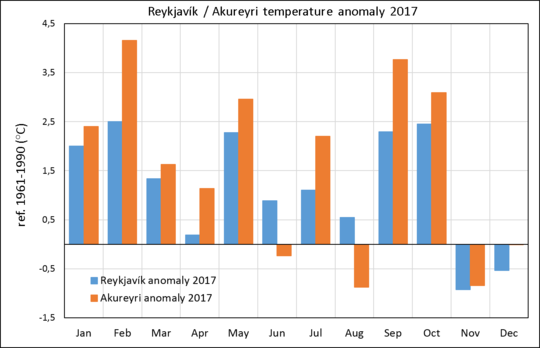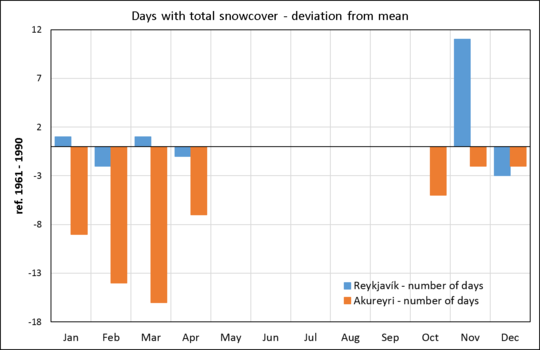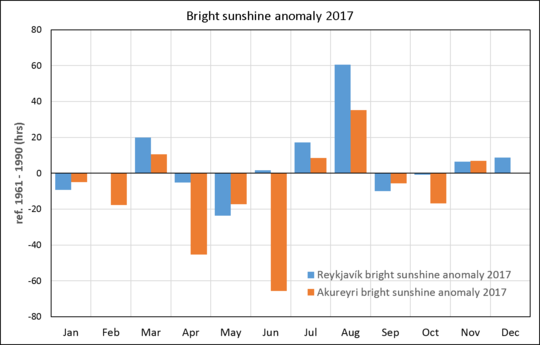The weather in Iceland in 2017
A short overview

The year 2017 was warm in Iceland and the weather was mainly favourable. February, May, September and October were particularly warm. The East had unusually much precipitation. Heavy rainfall in the East and Southeast at the end of September resulted in extensive flooding from major rivers in the area. The last two months of the year were considerably cooler than the previous months. November was cold and the last days of December were the coldest days of the year. Wind speed was slighly lower than average.
Temperature
The annual average in Reykjavík was 5.5°C, 1.2°C above the 1961 to 1990 mean, but equal to the mean of the last ten years (2007-2016). In Stykkishólmur the average temperature was 4.9°C, 1.4°C above the 1961 to 1990 mean. In Akureyri the average was 4.9°C, 1.7°C above the mean and it was the fifth warmest year in a series extending back to 1881. In Vestmannaeyjar the mean was 5.7°C , 0.8°C above the 1961 to 1990 mean. In Egilstaðir the annual average was 4.8°C, it was the second warmest year since the start of measurements in 1954, 2014 was warmer. In the country as a whole the temperature was 1.4°C above the 1961 to 1990 mean and 0.3°C above the mean of the last ten years (2007 to 2016).
The annual mean was highest in Surtsey, off the Southern coast, 6.6°C, but lowest -1.5°C at the glacial station Brúarjökull in the Central Highlands. The lowest annual temperature in inhabited areas, 2.0°C was measured at Möðrudalur in the north-eastern uplands.
The year 2017 was relatively warm and the annual mean at almost all of the stations was warmer than the mean of the last ten years (2007-2016). The positive deviations from the ten year average were overall largest in the Northeast. The largest positive deviation was +1.0°C in Eyjabakkar (in the East Highlands) but the largest negative deviation was -0.3°C in Laufbali (in the Southern Highlands).

The temperature was above normal in Reykjavík in all months except the last two months of the year. In Akureyri, the temperature was below normal in June, August, November and slightly below in December. It was exceptionally warm in February, May, September and October, especially in Akureyri.
The absoulute maximum temperature of the year was recorded at the station Végeirsstaðir in Fnjóskadal in the East on 25 July, 27.7°C, but the lowest minimum -29.0°C at Svartárkot in the north-eastern upland on 29 December.
The absolute maximum in Reykjavík was 22.5°C, recorded on 27 July and the absolute minimum was -8.5°C on 11 December. In Akureyri the maximum was 24.1°C on 22 July and the minimum was -17.9 on 29 December.
Precipitation
The precipitation was above the 1971 to 2000 mean at most stations. The excess was largest in the East. Heavy rainfall in the East and Southeast at the end of September resulted in extensive flooding from major rivers in the area.
The annual total in Reykjavík was 900.4 mm, 10 percent above the 1971 to 2000 mean. In Akureyri the total was 594.9 mm, 15 percent above the 1971 to 2000 mean. At Dalatangi in the East the precipitation was 2169.5 mm and has only once been larger since the start of the measurements there in 1938 (it was more 1950).
The number of days with precipitation equal to or exceeding 1 mm, were 157 in Reykjavík, 9 more than during an average year 1961 to 1990. In Akureyri such days were 120 in 2017, 17 more than the average.
The absolute maximum 24-hr precipitation was measured on 24 June at Skjaldþingsstaðir in the East, 187.9 mm. The largest 24-hr amount measured in Reykjavík was 28.6 mm, 11 June, and in Akureyri 23.7 mm on 12 October.

Precipitation in Reykjavík was far above normal in February, April and May. Precipitation was below normal during the summer (June to August) and October was relatively dry in Reykjavík. In Akureyri the precipitation was heavy in February, September and November, and particularly heavy in May. March and July were relatively dry in Akureyri.
Snow
Snow covered the ground for 59 days in Reykjavík, 1 fewer than on the average 1971 to 2000. A record snow depth for February was reached in Reykjavík after a heavy snowfall on 26 February, the total accumulation was 51 cm. This has only once been exceeded, in January of 1937 when the snow depth was 55 cm.
There was not much snow in Akureyri in 2017. Snow covered the ground completely for 50 days, 52 fewer than on the average 1971 to 2000. Days with total snow cover have never been so few in Akureyri since snow cover observations started in 1924.
The greatest snow depth measured in the country was 120 cm, at Lambavatn in the West on 26 February.

The number of days with snow cover in Reykjavík was around normal, but well above normal in November. The snow cover was unusually light in Akureyri, especially during the first four months of the year.
Bright sunshine duration
The number of bright sunshine hours in Reykjavík was 1334.5 during 2017, 66 above the 1961 to 1990 mean, but 91 fewer than the mean of the last ten years (2007 to 2016). In Akureyri the total was 932.8, 112 below the 1961 to 1990 average and 137 fewer than the mean of the last ten years (2007 to 2016).

August was sunny in Reykjavík, but in most of the other months the sunshine duration was around normal. There was particularly little sunshine in Akureyri in April and June. August was sunny but sunshine duration was close to normal during the other months of the year.
Sea level pressure
The annual average in Reykjavík was 1005.2 hPa, 0.7 below the 1961 to 1990 mean.
The absolute highest pressure of the year was measured at Reykjavík airport on 1 January, 1041.0 hPa, but the lowest at Gufuskálar in the West on 24 February, 951.7 hPa.

Sea level pressure was not far from average during most months of 2017. The positive anomalies were largest in January, November and December. The negative anomalies were largest in February, June, July and September.
Wind speed
The average wind speed at all stations were slightly lower than the average of 1961 to 1990.

The wind speed was below the 1961 to 1990 mean during the first three months of the year. Above average from April to July and below the average for the rest of the year, except for November.

All wind observations at manned stations are decomposed into an easterly and northerly component and compared to the 1961 to 1990 mean. Winds from the East and North are defined positive, but West and South winds negative. Southerly winds (orange) prevailed in January, February and September but Northerly in May, June, August and the last two months of the year. Westerly winds (blue) were above average in January and the last three months of the year, but Easterly in February, May, June and July.
A short overview of the individual months
January
January was favourable. It was relatively warm and snow cover was light in lowlands. Precipitation was close to average. Stormy weather was not as common as usual at this time of the year.
February
February was unusually warm, especially in the north and east. Precipitation was well above average, particular in the south and west. Snow cover was very light all over the country until the 26th when heavy snowfall hit the West. A record snow depth for February was reached in Reykjavík, the total accumulation was 51 cm. This has only once been exceeded, in January of 1937 when the snow depth was 55 cm.
March
The weather was favourable for most of the month. Temperature was close to average and precipitation below average, except in the east. The overall wind speed over the whole country was considerably lower than normally in March
April
April was wet, especially in the west and northwest where April precipitation has not been so heavy for decades. Temperature was close to average. Weather was mainly favourable.
May
May was unusually warm and temperature was well above average. The first week was particularly warm and also the days around the 21st. Precipitation was above average in most places. The total in Reykjavík was 84.4 mm, 92 % above average. In Akureyri the total was 62.2 mm. This is the wettest May in Akureyri since the start of precipitation measurements in 1928.
June
Weather was quite favourable in June. Temperature was above the 1961 -1990 average in most places, but below the mean of the last ten years. Precipitation was well above average in the east. It was gloomy in the North and bright sunshine hours in Akureyri have not been so few in June since 1972.
July
Weather was favourable in July. It was warm in most part of the country, although it felt cold in the southwest for the first half of the month. It was rather dry month in most areas.
August
August was favourable month. Calm weather and precipitation below normal, except in the north. The number of sunshine hours was high in the southwest.
September
September was warm and wet, especially in the east. The first days were very warm and again few days near the middle of the month. It was particularly warm in the east and northeast during these days. The temperature reached 20 degrees in many places and maximum temperature record for September was exceeded on the 1st when the temperature was measured 26.4 degrees at Egilsstadir airport. The older record was 26.0 degrees, measured at Dalatangi on the 12th of September, 1949. Winds from South and East prevailed in the month. Heavy rainfall in the east and southeast at the end of September resulted in extensive flooding from major rivers in the area.
October
Weather was favourable in October. It was unusually warm and temperature was well above average all over the country. It was rather dry in the west but wetter in the east and southeast. Winds were light.
November
November was cold, in contrast with the previous months of the year which have mainly been warm. Windstorm from the North prevailed during the 21st – 24th of November, causing heavy snow in the north and east and traffic disruption.
December
December felt cold but the weather was calm. The last days of the year were particularly cold, especially in the northeast. Precipitation and wind speed were below average.




